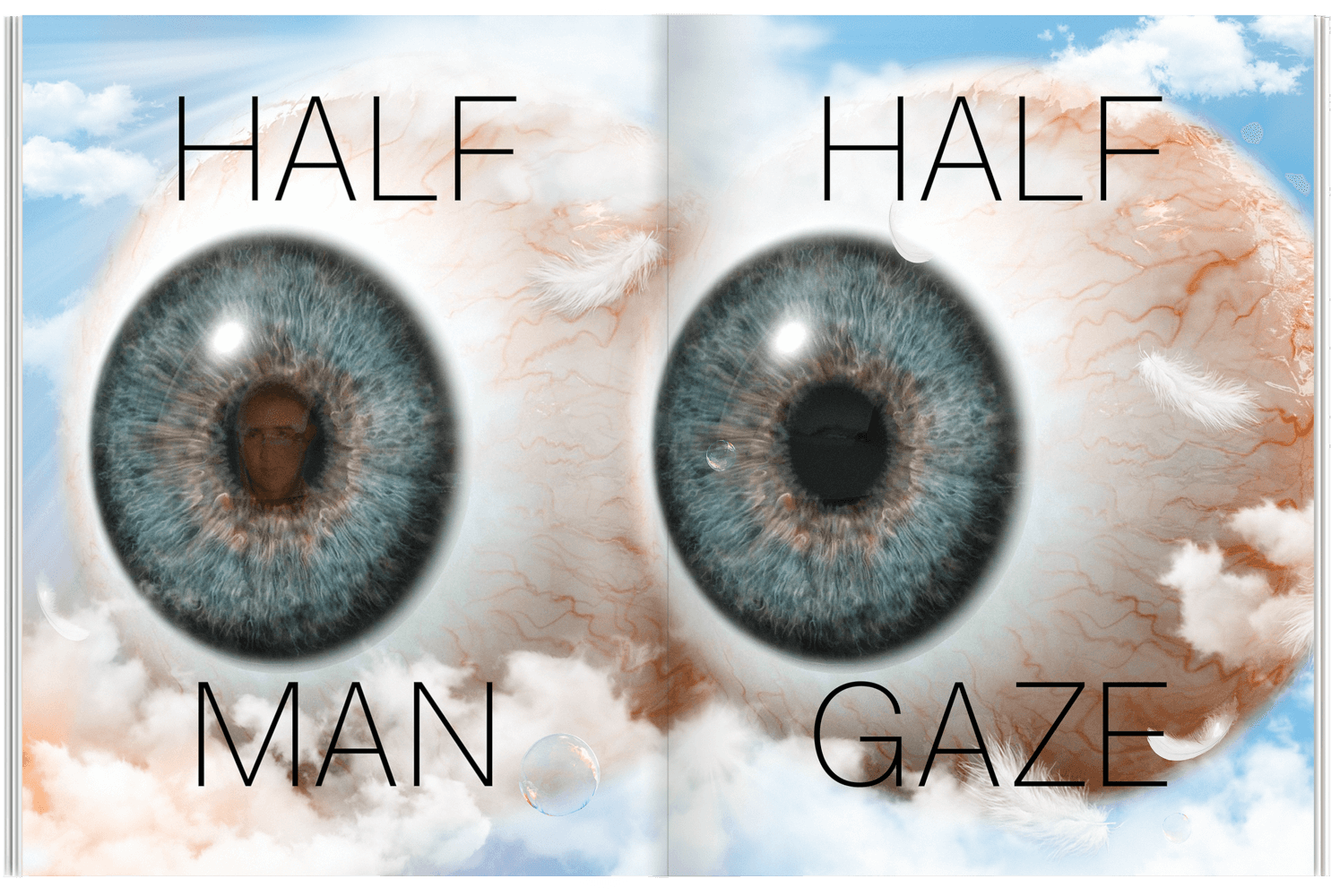
Thursday, January 7, 2010, 7:00 PM, Hawaii, Hilton Waikiki Prince Kuhoi Hotel, Earth Transformation Conference.
“When smashing monuments, save the pedestals, they always come in handy.” - Stanislaw Lec
Petroleum and vanilla-coloured splotches shaped like boats and sea anemone on a pastel turquoise carpet, wood panels with grey-green tiles on the walls. Glass panels in the shape of waves hang from the ceiling to create an oceanic atmosphere; the interior design of the conference room evokes that we are underwater. Algae-green seat covers over chairs in neatly aligned rows face a foreboding podium, decorated with flower bouquets. A backdrop of white drapes is flanked by two human-size indoor palms. Two spotlights shine onto the empty stage. Whoever steps onto it will have to deal with its sub-aquatic implications.
The conference organiser Angelika Whitecliff — co-founder of galacticdiplomacy.com, a website devoted to researching secretly conducted diplomatic relationships of multiple large nations with extraterrestrials — introduces the phenomenon we are about to witness: the miraculous gaze of Braco [brat͡so]. If Whitecliff has any authority about what aliens can offer us, Braco seems to be what she has in mind in return. Who the aliens are, of course, depends on who you ask: this is the USA's first close encounter with Braco — who was directly invited by Whitecliff to open the conference. She will, in the following years, function as one of the many announcers to the viewing sessions of Braco's supernatural gaze. Braco himself doesn't speak.
Now it’s time. As Whitecliff has left the stage, Braco is led into the room by an assistant. He steps on the podium and goes right at it. A man in his forties with silver hair that falls over his shoulders, a white button-up lingering over dad-denims, arms falling to the side, each wrist in a golden bracelet. Nothing to distract one’s sight from his piercing yet trusting, loyal — I want to say longing — eyes. He looks peaceful, a bit like a tourist but with a secret.
His audience stands transfixed before him, some wet hands clasp those of a neighbour, bodies shudder, tears roll over cheeks. After ten minutes, Braco leaves the stage as abruptly as he had appeared on it and exits the room through the same door.
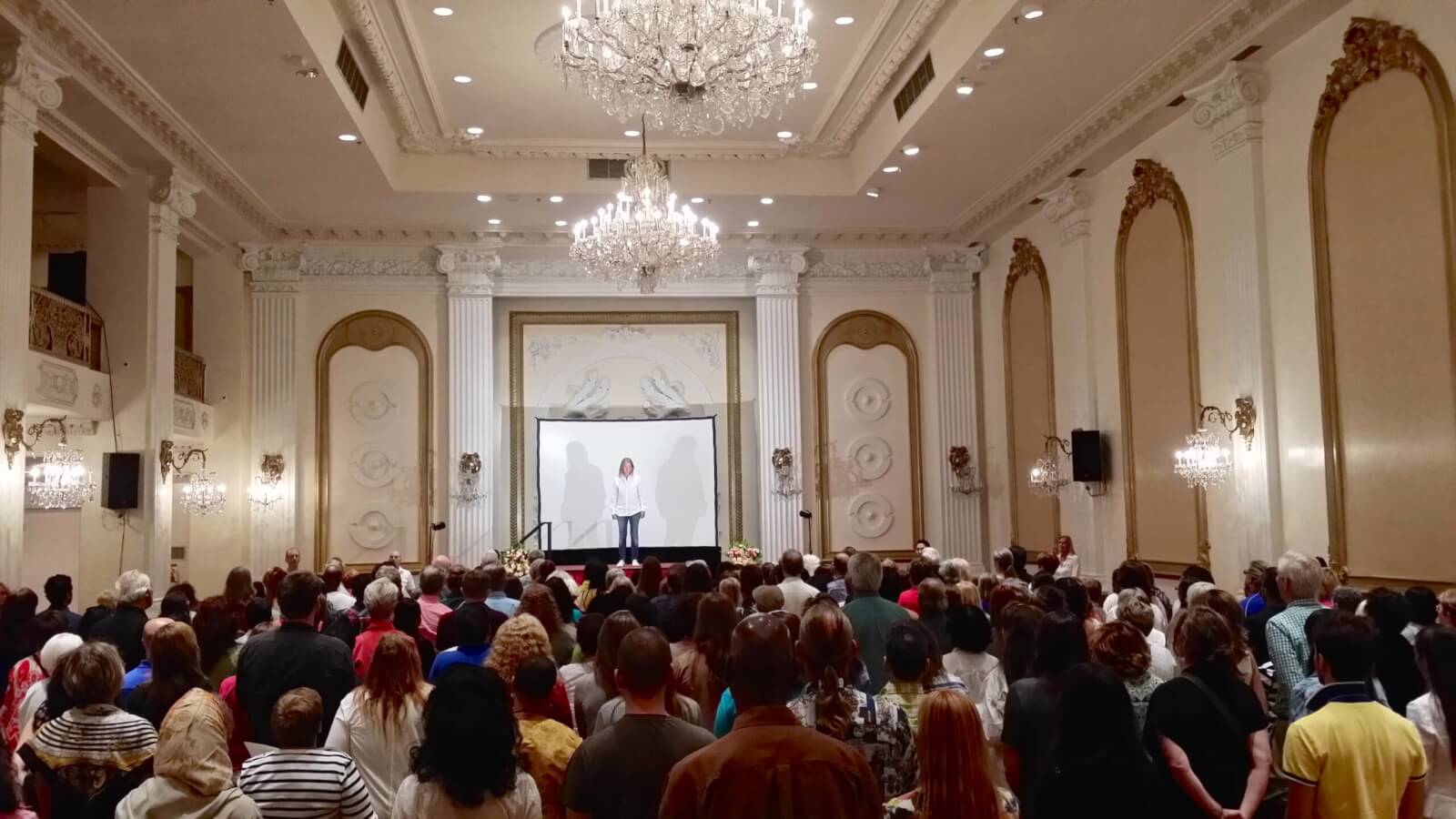
braco.me, unknown photographer
THE PHENOMENON OF BRACO
The Earth Transformation Conference was Braco's first appearance of his inaugural US tour. After Hawaii came California, Nevada, and the East Coast. By 2018, the Croatian-born Braco has toured the US yearly, while visiting Japan, Australia, Central America, Russia and Europe several times. In the meantime, Braco has gazed at the UN's chapel, Naomi Campbell, several Indonesian Princes and at the attendees of various UFO and peace conferences across the planet. He is quite the phenomenon; and a well-known staple of the Balkan New Age imaginary. But before we turn to his gaze itself, I would like to take a closer look at the man that is looking at us.
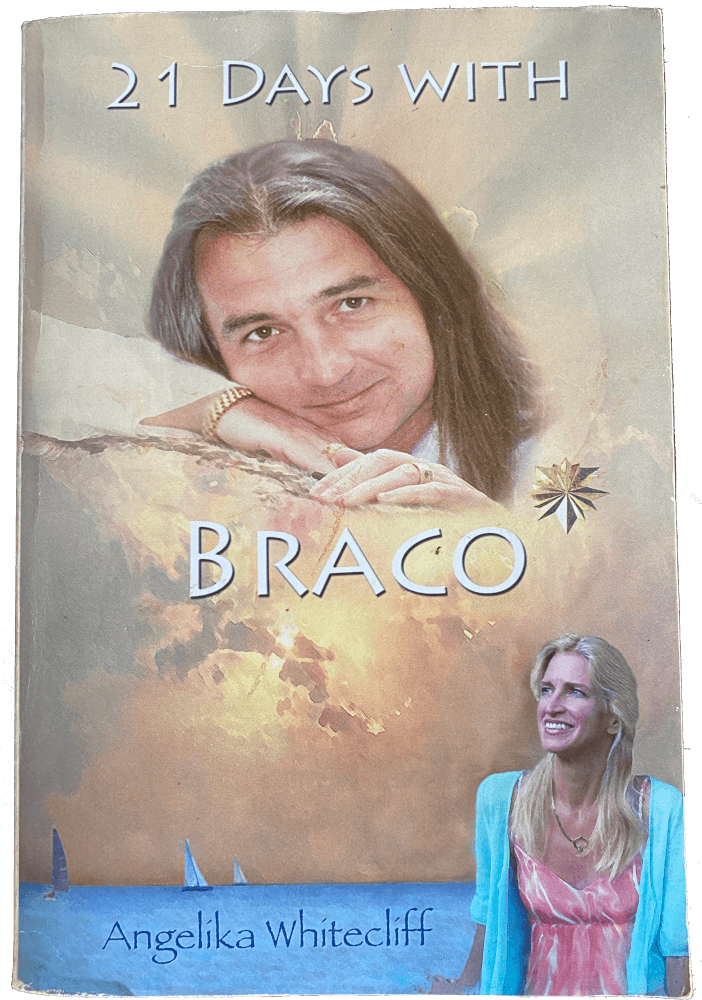
The Croatian War of Independence broke out in 1991, just as the 24-year-old Josip Grabavac received his Master's degree in economics from the University in Zagreb. Shortly thereafter he began working for the Serbian economist Toplica Prokić, also known as Ivica, who was a well-known Zagreb-based healer. Apparently, it was childhood visions that evoked Ivica’s healing powers, which he performed in Zagreb throughout the 80s, all while selling books and gathering a large following. Ivica became Grabavac’s mentor and gave him his name Braco — meaning ‘little brother’. According to Whitecliff (who also happens to be Braco's biographer1), Braco’s gaze manifested itself after Ivica and Braco took a holiday trip together. A deleted section in his Wikipedia article states that “The two were alone on a beach in South Africa, when Braco said a rogue wave swept Prokić away and killed him! Setting out on the harsh task of continuing a legacy, Braco returned alone to Ivica’s numerous followers in Zagreb and took over his headquarters.
On his website (braco.me) one encounters an inventory of products and media output that Braco has produced over the years: several DVDs, books, CDs of the music played during gazing sessions, as well as jewellery with his trademark 13-ray sun symbol. One can read articles written by a whole choir of apostles — ‘scientists’ and ‘psychologists’ testifying in support of his cause. My favourite thing about the website, however, is the live stream. Three days a month, the gaze is broadcast hourly. These sessions are interspersed with expert testimonies about the miraculous qualities of his gaze, interviewed by a woman with moderation cards, who leads the program like a TV-host. Announcements of upcoming events and motivational video clips precede the live image, and then it’s time — the moderator asks us to “stand up in front of the screen.” Braco enters the frame. Behind him a polished onyx backdrop with his sun symbol, flanked by lilies. The room's bright and polished design resembles a modern crematorium. As the camera zooms in, he gently lifts his eyes, et voilà. Ten minutes of live gazing are followed by slow motion videos depicting horses galloping through a body of water to New Age music. On a recent stream, some 2.600 viewers (mostly from Germany and the US) were watching with me. Who are these followers? What have they been coming to this site for?
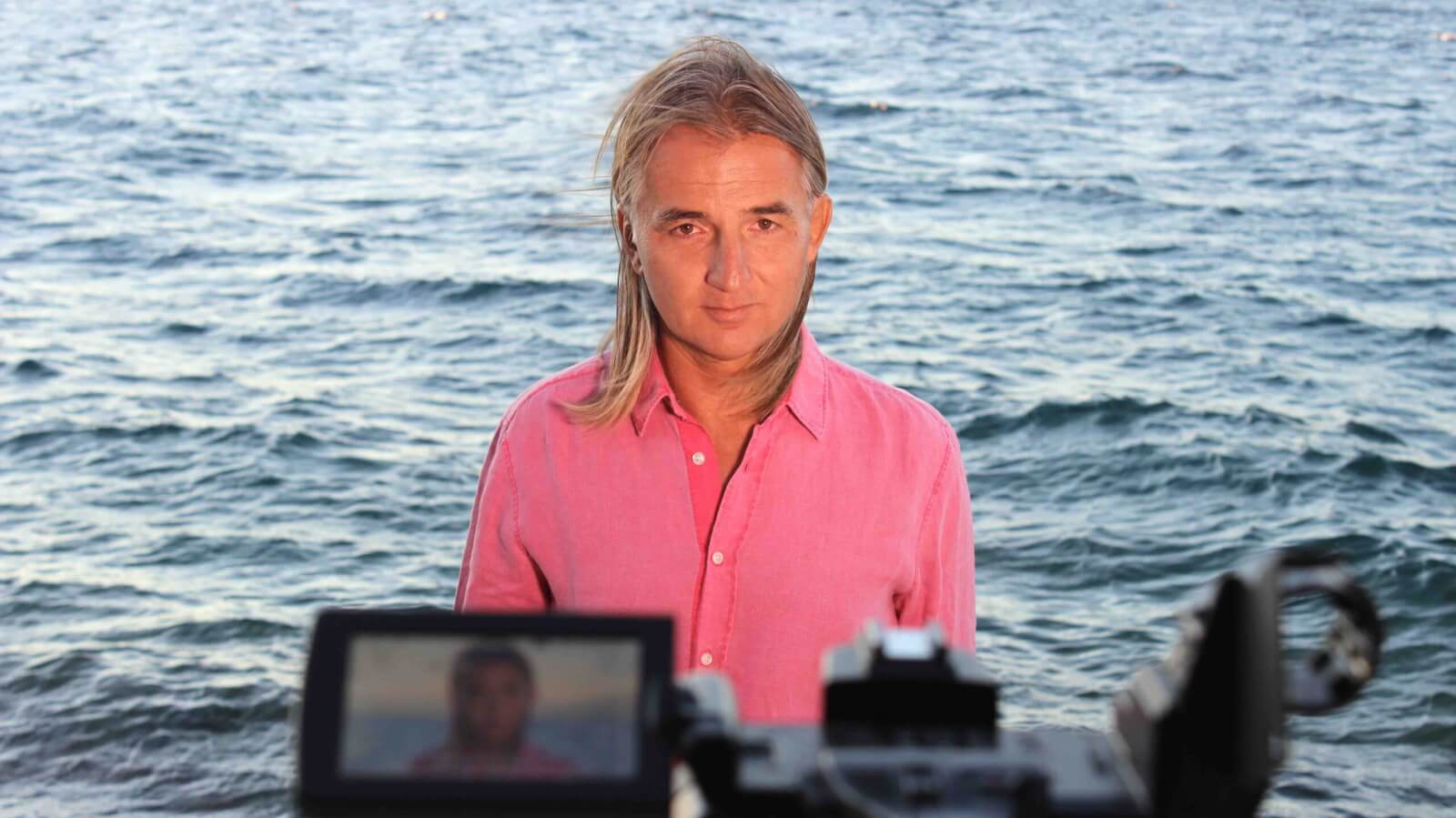
braco.me, unknown photographer
“They describe warm, piercing rushes, pains disappearing, ailments long thought fatal lifted.“
BENEVOLENT SURVEILLANCE
Although no explicit promises are made by Braco himself, the interviews with experts and those previously looked at, suggest that there is something healing and wholesome radiating from his gaze. They describe warm, piercing rushes, pains disappearing, ailments long thought fatal lifted. I would argue, though, that the healing offered to an audience in Zagreb throughout and after an independence war — one with horrific war crimes, based on repressed political and ethnic tensions, leaving lasting societal trauma — is a different kind of healing from that which people come to seek at the Hilton Hotel in Hawaii in 2010. When Braco turned his gaze to the West Coast of the US, he entered an already established globalised New Age market, with a different kind of audience. Neoliberalism has by no means spared New Ageism, or vice versa. Quite the opposite. The incarnation of esotericism that we call New Age emerged in the 1980s out of British and US-American marketing systems that organised and commercialised a whole plethora of belief systems through a network of crystal shops, festivals, fairs, magazines and self-help guides. New Age also gained traction in Eastern Europe after the fall of the socialist regimes in its different countries and has produced specific milieus for esoteric beliefs, possibly connected to the ideological repression of religion and spirituality during the period. A large part of the European Rainbow Gatherings are held in Eastern Europe; the UFO religion Ashtar in the Czech Republic, Lithuanian neoshamanism or the Bosnian pyramid claims are just a few examples to name.
By now New Age appears to have converged harmonically with the California Ideology principles and the individual freedoms at the heart of the liberal ideology to yield a flourishing cult of the self, inevitably connected to spa, fitness, wellness, healing and organic food. This movement of health and healing however is not for everyone. In accordance with its neoliberal agenda, the rebirth of New Age we encounter in the metropolises of US and Europe today must be identified as a class project that caters mainly to the wealthy. Celebrity doctors, personal fitness trainers, wellness centres housed in clubs and gated communities are the altars of this resurrection of the old privilege of ‘the care of the self’. At the onset, Braco’s own viewing sessions were introduced free of charge and directed at marginalised and rural communities in Croatia, rather than the wealthy and privileged in California. With his shift to an international market, a commercial sensibility rooted in marketing strategies has crept into his appearance, which might throw off some of his original admirers.
In his Lectures The Hermeneutics of Subject, Michel Foucualt theorised the notion of ‘the care of the self’ (epimeleia heautou). This concept, usually secondary to the Delphic prescription to ‘know thyself’ (gnōthi seauton), is for Foucault central to pre-modern thought. The care of the self is a conscious examination of the self and, beyond that, a moral practice, connected to rituals of purification, education and knowledge production. It didn’t connote negative assumptions such as self-centeredness or egoism, yet in Hellenistic times, there was already an implication of a class project in place. The care for the self, the examination of the self was a privilege and a status symbol that had to be practiced specifically by those that were in a position to govern others. It was an ethical prerequisite to know how to take care of oneself, before deigning to take care of others.
As much as Braco is gazing at us, he is also watching us. When we step in front of Braco, we enter the nightmare of Michel Foucault’s theorisation of surveillance, especially in relation to Bentham's Panopticon. Braco embodies a powerful surveilling eye on a stage, seen-by-all and seeing-all, hovering above the audience. We, the looked-at, come to be seen by him, to be recognised and ultimately healed by his surveillance. This contemporary desire to be seen turns the Hellenistic notion of the care of the self from the premise of self-observation into an act of self-surveillance. A holistic self-management that tracks nutritional facts, heart rate and credit card expenditure, all in one operation, while comparing my Mayan Astrology chart to my ‘organic’ SEOs and ROIs. From body activity tracking apps to social media accounts, every rule of 20th century privacy is transgressed through the simple ideological operation known as ‘sharing’ — of ones data, privacy and likes with friends, colleagues and Instagram. The Quantified Self movement, which is emblematic of this desire for self-surveillance, was initiated by the Wired magazine editors, Gary Wolf and Kevin Kelly, in 2007. Their website promotes “self knowledge through numbers”. Through tracking sensors and monitors, everyone’s body activity is understood as an empirical study that renders the body into an interface, capable of interacting with products in more minute and specific ways. The theatricality of this desire for self-surveillance is present in the phenomenon of Braco’s gaze, and becomes especially apparent by the nature of Braco’s live-streamed gaze.
Braco renders the acceptance of the ubiquitous surveillance cameras in our lives, on our devices, in our offices and public spaces into a benevolent gaze. He thereby seeks to be part of our lives on a regular basis, like a therapist, several times a month. He craves to appear on our Apple Watch during cardio mode at the Equinox treadmill, as the spiritual translation for our desire to be seen.
Through this Braco becomes the camera on our Phone, his gaze represents the good-hearted eye of surveillance that you need in order to ‘know thyself’.
THE PRESENCE
As I am walking away from this reading of Braco’s gaze, I grow pensive. After all, the Braco phenomenon is perhaps less specific to Braco himself than it would initially appear. All of a sudden, I realise that I recognise his gesture of silent gazing as a mode used in performance art. And when I say performance art I think of Marina Abramović’s renowned piece The Artist is Present, performed for over 700 hours in the atrium of MoMA, during which Abramović sat motionless in a chair inside a black square. One visitor at a time was invited to sit in an empty chair in front of her and, without speaking, hold eye contact. Over 1500 visitors sat to be looked at by Abramović between March and May of 2010 (the same year of Braco’s first US tour). Multiple photo blogs have documented her visitors, most memorable of which is the collection of those who Marina brought to tears.
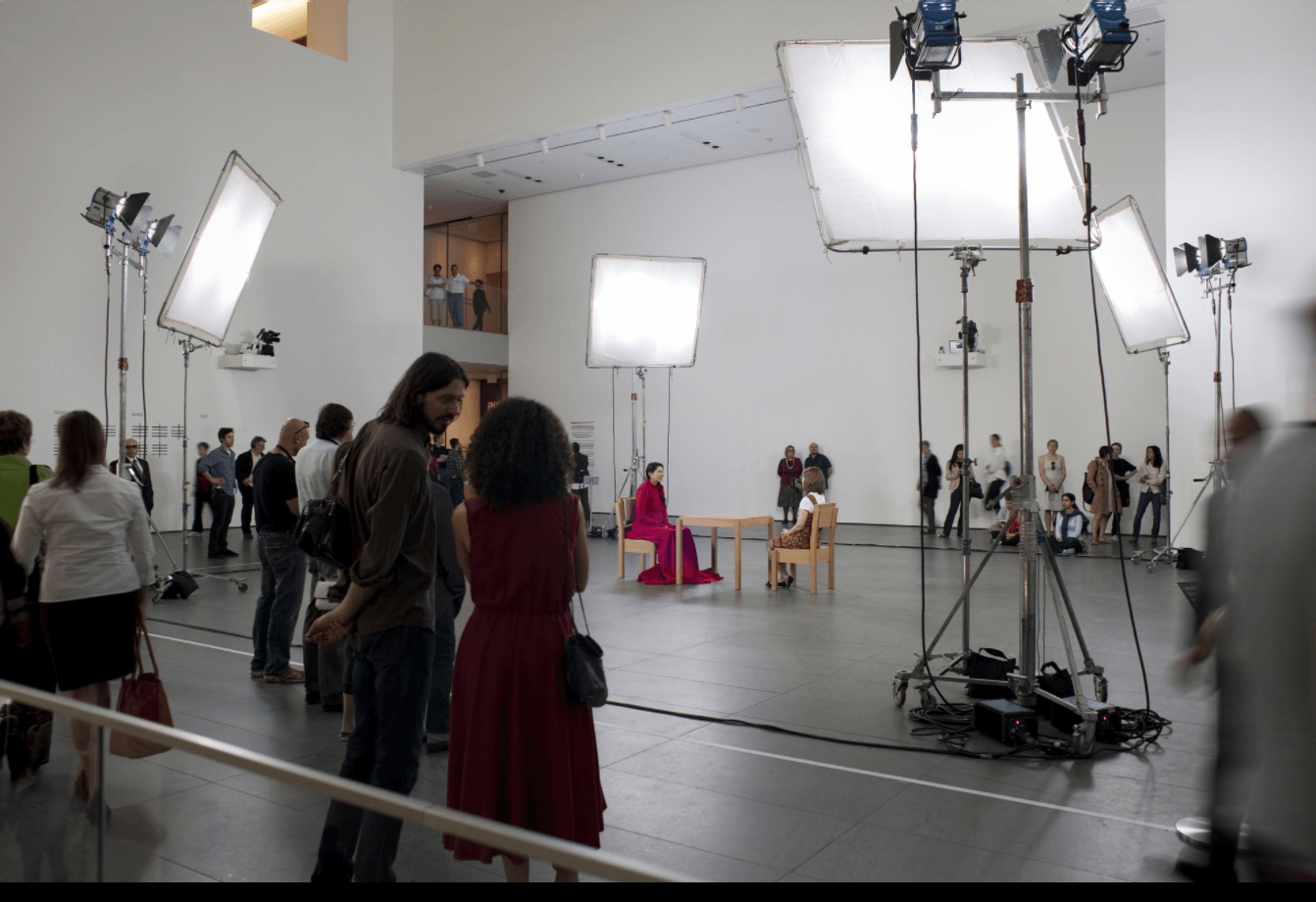
A Marina Abramović performance during ‘Marina Abramović: The Artist is Present’ at MoMA, New York in 2010. Wikimedia Commons
Through Abramović, an important element of the gesture of gazing becomes apparent. It is the gaze of the third: the spectator. It’s not just the artist who is present. There is a whole array of objects and context that is regularly left out of the description of the piece: spotlights in each corner of the square, photographers documenting every reaction, hours of waiting in line, the architecture of MoMA itself, the online fuss about celebrity visitors. It’s this entire choreography of being watched by others while being watched by Abramović that makes the stuff of her performance. Both Abramović’s and Braco’s gazes are highly contextualised by narrations and expectations. Braco’s live-stream moderator asks us, just before he enters the frame, to “try to create an energy of expectation and surrender to your feelings.” There is a thick forest of healing platitudes, world peace, and Balkan exoticisation that we have to pass before we can encounter Braco’s gaze.
From the 1970s on, Abramović’s performances addressed body politics and specifically dealt with the way internalised totalitarian regimes find representation in actions performed on the body that could be dubbed as practices of carelessness of the self. In Rhythm 5 (1974) she placed herself inside a burning frame in the shape of the red star. The performance simultaneously evoked a purification ritual, a satanic sacrifice and an exercise in communal awareness (she had to be rescued by the audience after she lost consciousness). I want to propose to read The Artist is Present along those lines of internalised and self-inflicted modes of power that render the artist’s body silent, immovable and reduced to a mere gaze by the spectacle of art institutions. The work was part of her first retrospective (curated by Klaus Biesenbach) that rehashed her performances for mass consumption (750,000 visitors) and exposed her body, and those of her audience, directly to the effects of hyper-capitalism’s attention economy. It reads like a post-socialist sequel to Romero's Dawn of the Dead, but this time the zombies invaded MoMA instead of a shopping mall.
Braco’s own immobility is perhaps born out of a similar post-socialist predicament, as he originally directed his healing powers at an audience with the specific trauma of the Croatian War of Independence. In the meantime, other traumas have crept in, multiplied and taken over the faces that meet Braco’s gaze, marking the transformation from local healer to global guru. Whoever Braco looks at, however, is exposed to this specific historicity of his gaze, for which he comes to stand-in as performative monument.
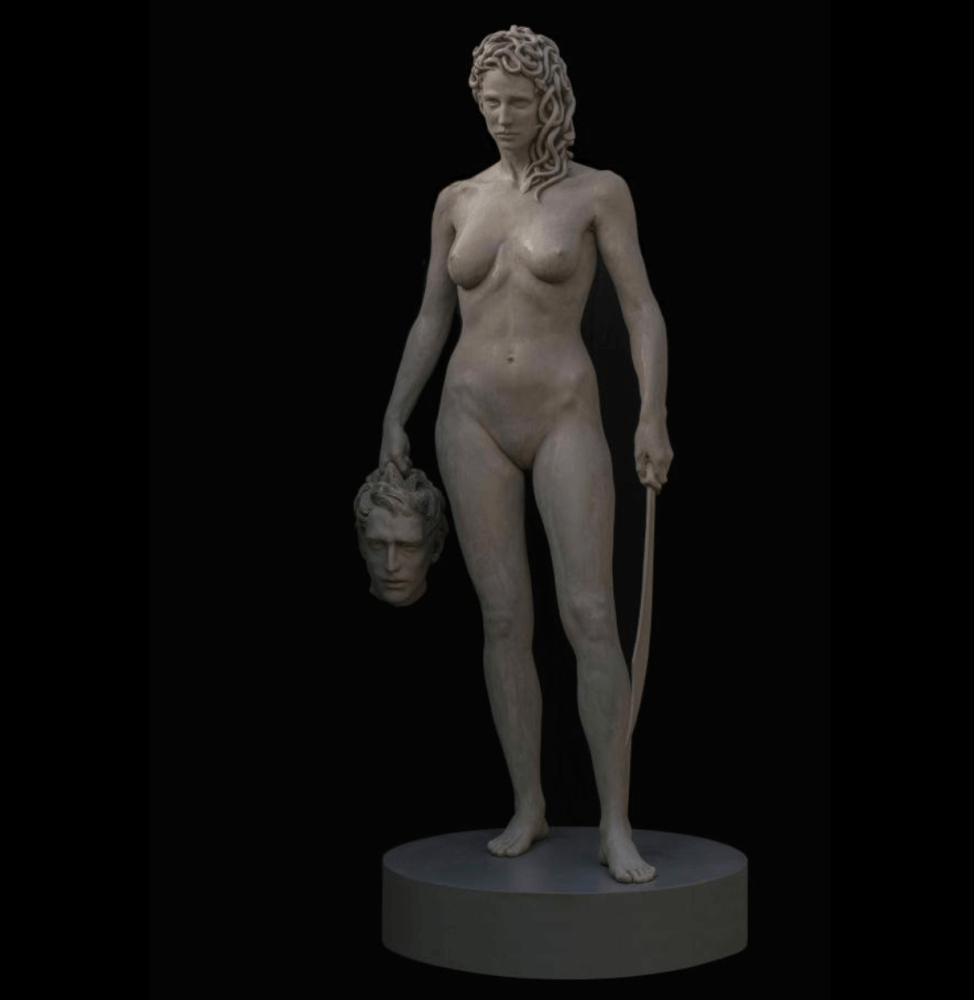
Medusa statue, wikimedia commons
MEDUSA'S GAZE
In psychoanalytic discourse, the mythological story of Medusa’s head was first employed by Freud in Das Medusenhaupt to explain the arresting fear that the boy-child experiences at the sight of his mother’s genitalia when he realises the absence of the penis. The fear of castration, provoked by this glance, causes a split in the (rather male) subject. For Lacan subjectivity is posited out of this split. The gaze, as a drive based on sight, seeks to incorporate the unfulfilled desires of being in the world while being distinct from it. Yet the gaze cannot ‘see inside’ and cannot turn towards the subject itself. It is a blind spot, a gap. Lacan comes up with the operation of seeing-oneself-seeing-oneself to explain this notion of perceiving an image of the self without being able to gaze inside. This, I would argue, relates to the notion of contemplation and self-observation that the care of the self addresses.
Considering the phallic quality of his gaze — erected on a stage above a crowd, the rather short duration and mediated climax of the splashing horses video after the live stream — Braco himself must be filled with libidinal desire to look at us. Yet through Lacan it becomes apparent that Braco is not looking at us but rather at himself, contemplating, filled with desire turned inside. He is performing the care of the self as a type of didactic exercise for the entrepreneur of the self. Prepared by experts, measured in followers, disseminated on screens — Braco's gaze turns self-care into what Michel Feher calls self-appreciation based on our human capital. Braco’s own contemplation turned entrepreneurship becomes part of the experience and charges his gaze symbolically. After all, a guru who is not a successful businessman is hardly guru that the neoliberal subject will follow. The figure of Medusa was later reclaimed by feminist critiques of psychoanalysis. In From Horrorism to Compassion cultural theorist Griselda Pollock unearths the phallocentric reading of the Medusa by both Freud and Lacan through the feminist scholar Jane Harrison. Medusa was originally a guardian, a Gorgoneion — which means a mask, an emblem to ward off evil. It portrayed a Gorgon — the face of a monster, not necessarily gendered but attributed to be a matriarchal symbol worn by Athena. By the time of Ovid the mask became embodied and gendered into the 'beautiful' Medusa, who is raped by Poseidon in Athena's temple, after which the latter shames her by placing the stigma-mask of the Gorgon onto her. Thereafter, anyone that Medusa looks at turns to stone. She finally emerges as opponent to the patriarchal hero Perseus, who sets out to slay Medusa. He carries her head/mask as a trophy (and representation of defeated matriarchal power) to ward off the suitor of his mother, rescue Andromeda as a damsel in distress from a sea snake, and place it as a necklace back around Athena’s neck, where the myth stole it from in the first place. Severed head, mask or necklace — the face of Medusa is understood to be apotropaic, warding off powers of the gaze with a gaze — such as that of the evil eye, or of invidia (envy). Medusa, the Gorgon, is a guardian that functions like a mirror triggered to a specific, ill-intentioned gaze — an evil eye for an evil eye. It’s the oscillation of the two Bracos as a double guardian that keeps on arresting his audience in a fundamental contradiction. We have to read Braco’s gaze as this double access to healing — one related to trauma and one to self-care. One eye stares with a post-socialist glare and the other with a neo-liberal one. As healing protector of the historicity of his gaze, born out of post-Yugoslav conflict, he confronts his international audience with a post-socialist experience alien to them. As guardian of the self-surveilling California Ideology entrepreneur, on the other hand, he exposes his original followers to the business kitsch of marketing and self-styling. On both sides, his followers behold each other as spiritual commercialisation meets trauma informed healing.
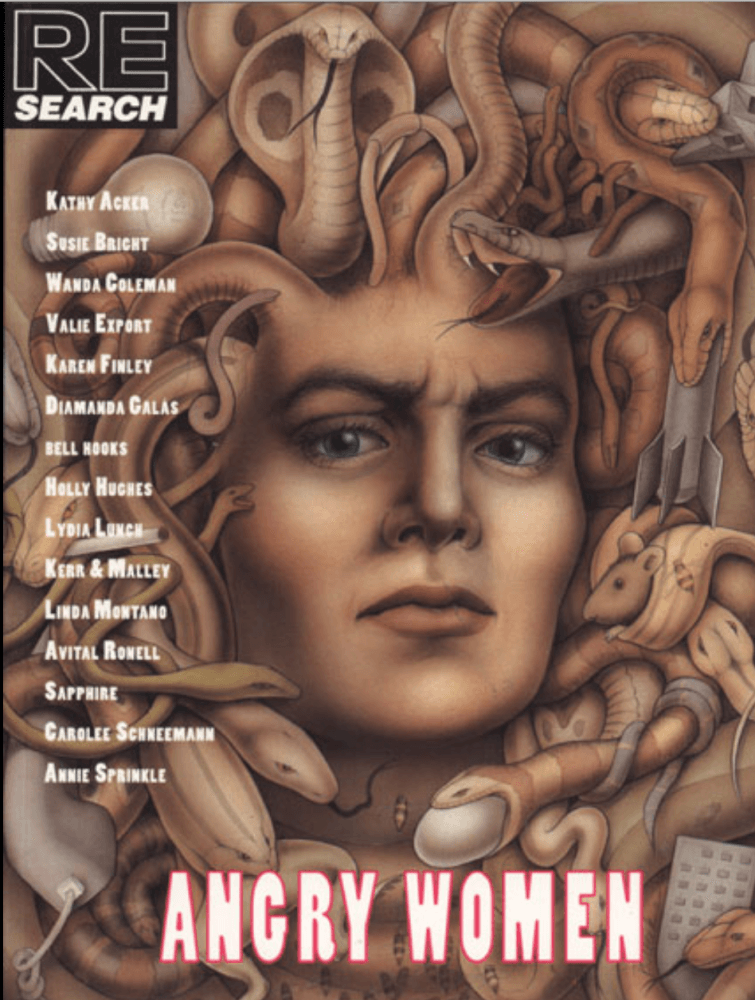
An enduring bestseller since its first printing in 1991
This guardian-ness is present in both Braco and Abramović. After all, it is not only us, the looked-at, that become immovable. It is their highly-mediated gazes turned inside, that petrify themselves above all. It is they who are placed on pedestals and on stages that turn to statues, icons, spomeniks. It is their bodies that find themselves arrested by the art world, by the world of esoteric healing and the freezing spotlights of their attention economies. Without speaking, Braco is in no position to tell us of this continuous catastrophe that will arrest him as long as we, the audience, come to participate in the deadlock of attention ourselves. Considering these performative monumentalisations as emerging modalities of arrest and detention of late hypercapitalism, in which the bodies of thousands of cognitive labourers are trapped in the iconography of TED talks, lectures and panel discussions, I call to imagine a new type of Iconoclasm. In this case however, I would like to disagree with the quote by the Polish satirist Lec I started the article with. Instead of the destruction of the monuments, I call for a destruction of their pedestals — those of the institutions: the Hilton Hotel conference room and the MoMA atrium — in favour of a rescue mission for the bodies that are trapped there to populate them.
Text: Maximum Wage
3D eyes: bus.group

Thursday, January 7, 2010, 7:00 PM, Hawaii, Hilton Waikiki Prince Kuhoi Hotel, Earth Transformation Conference.
“When smashing monuments, save the pedestals, they always come in handy.” - Stanislaw Lec
Petroleum and vanilla-coloured splotches shaped like boats and sea anemone on a pastel turquoise carpet, wood panels with grey-green tiles on the walls. Glass panels in the shape of waves hang from the ceiling to create an oceanic atmosphere; the interior design of the conference room evokes that we are underwater. Algae-green seat covers over chairs in neatly aligned rows face a foreboding podium, decorated with flower bouquets. A backdrop of white drapes is flanked by two human-size indoor palms. Two spotlights shine onto the empty stage. Whoever steps onto it will have to deal with its sub-aquatic implications.
The conference organiser Angelika Whitecliff — co-founder of galacticdiplomacy.com, a website devoted to researching secretly conducted diplomatic relationships of multiple large nations with extraterrestrials — introduces the phenomenon we are about to witness: the miraculous gaze of Braco [brat͡so]. If Whitecliff has any authority about what aliens can offer us, Braco seems to be what she has in mind in return. Who the aliens are, of course, depends on who you ask: this is the USA's first close encounter with Braco — who was directly invited by Whitecliff to open the conference. She will, in the following years, function as one of the many announcers to the viewing sessions of Braco's supernatural gaze. Braco himself doesn't speak.
Now it’s time. As Whitecliff has left the stage, Braco is led into the room by an assistant. He steps on the podium and goes right at it. A man in his forties with silver hair that falls over his shoulders, a white button-up lingering over dad-denims, arms falling to the side, each wrist in a golden bracelet. Nothing to distract one’s sight from his piercing yet trusting, loyal — I want to say longing — eyes. He looks peaceful, a bit like a tourist but with a secret.
His audience stands transfixed before him, some wet hands clasp those of a neighbour, bodies shudder, tears roll over cheeks. After ten minutes, Braco leaves the stage as abruptly as he had appeared on it and exits the room through the same door.

THE PHENOMENON OF BRACO
The Earth Transformation Conference was Braco's first appearance of his inaugural US tour. After Hawaii came California, Nevada, and the East Coast. By 2018, the Croatian-born Braco has toured the US yearly, while visiting Japan, Australia, Central America, Russia and Europe several times. In the meantime, Braco has gazed at the UN's chapel, Naomi Campbell, several Indonesian Princes and at the attendees of various UFO and peace conferences across the planet. He is quite the phenomenon; and a well-known staple of the Balkan New Age imaginary. But before we turn to his gaze itself, I would like to take a closer look at the man that is looking at us.

The Croatian War of Independence broke out in 1991, just as the 24-year-old Josip Grabavac received his Master's degree in economics from the University in Zagreb. Shortly thereafter he began working for the Serbian economist Toplica Prokić, also known as Ivica, who was a well-known Zagreb-based healer. Apparently, it was childhood visions that evoked Ivica’s healing powers, which he performed in Zagreb throughout the 80s, all while selling books and gathering a large following. Ivica became Grabavac’s mentor and gave him his name Braco — meaning ‘little brother’. According to Whitecliff (who also happens to be Braco's biographer1), Braco’s gaze manifested itself after Ivica and Braco took a holiday trip together. A deleted section in his Wikipedia article states that “The two were alone on a beach in South Africa, when Braco said a rogue wave swept Prokić away and killed him! Setting out on the harsh task of continuing a legacy, Braco returned alone to Ivica’s numerous followers in Zagreb and took over his headquarters.
On his website (braco.me) one encounters an inventory of products and media output that Braco has produced over the years: several DVDs, books, CDs of the music played during gazing sessions, as well as jewellery with his trademark 13-ray sun symbol. One can read articles written by a whole choir of apostles — ‘scientists’ and ‘psychologists’ testifying in support of his cause. My favourite thing about the website, however, is the live stream. Three days a month, the gaze is broadcast hourly. These sessions are interspersed with expert testimonies about the miraculous qualities of his gaze, interviewed by a woman with moderation cards, who leads the program like a TV-host. Announcements of upcoming events and motivational video clips precede the live image, and then it’s time — the moderator asks us to “stand up in front of the screen.” Braco enters the frame. Behind him a polished onyx backdrop with his sun symbol, flanked by lilies. The room's bright and polished design resembles a modern crematorium. As the camera zooms in, he gently lifts his eyes, et voilà. Ten minutes of live gazing are followed by slow motion videos depicting horses galloping through a body of water to New Age music. On a recent stream, some 2.600 viewers (mostly from Germany and the US) were watching with me. Who are these followers? What have they been coming to this site for?

braco.me, unknown photographer
“They describe warm, piercing rushes, pains disappearing, ailments long thought fatal lifted.“
BENEVOLENT SURVEILLANCE
Although no explicit promises are made by Braco himself, the interviews with experts and those previously looked at, suggest that there is something healing and wholesome radiating from his gaze. They describe warm, piercing rushes, pains disappearing, ailments long thought fatal lifted. I would argue, though, that the healing offered to an audience in Zagreb throughout and after an independence war — one with horrific war crimes, based on repressed political and ethnic tensions, leaving lasting societal trauma — is a different kind of healing from that which people come to seek at the Hilton Hotel in Hawaii in 2010. When Braco turned his gaze to the West Coast of the US, he entered an already established globalised New Age market, with a different kind of audience. Neoliberalism has by no means spared New Ageism, or vice versa. Quite the opposite. The incarnation of esotericism that we call New Age emerged in the 1980s out of British and US-American marketing systems that organised and commercialised a whole plethora of belief systems through a network of crystal shops, festivals, fairs, magazines and self-help guides. New Age also gained traction in Eastern Europe after the fall of the socialist regimes in its different countries and has produced specific milieus for esoteric beliefs, possibly connected to the ideological repression of religion and spirituality during the period. A large part of the European Rainbow Gatherings are held in Eastern Europe; the UFO religion Ashtar in the Czech Republic, Lithuanian neoshamanism or the Bosnian pyramid claims are just a few examples to name.
By now New Age appears to have converged harmonically with the California Ideology principles and the individual freedoms at the heart of the liberal ideology to yield a flourishing cult of the self, inevitably connected to spa, fitness, wellness, healing and organic food. This movement of health and healing however is not for everyone. In accordance with its neoliberal agenda, the rebirth of New Age we encounter in the metropolises of US and Europe today must be identified as a class project that caters mainly to the wealthy. Celebrity doctors, personal fitness trainers, wellness centres housed in clubs and gated communities are the altars of this resurrection of the old privilege of ‘the care of the self’. At the onset, Braco’s own viewing sessions were introduced free of charge and directed at marginalised and rural communities in Croatia, rather than the wealthy and privileged in California. With his shift to an international market, a commercial sensibility rooted in marketing strategies has crept into his appearance, which might throw off some of his original admirers.
In his Lectures The Hermeneutics of Subject, Michel Foucualt theorised the notion of ‘the care of the self’ (epimeleia heautou). This concept, usually secondary to the Delphic prescription to ‘know thyself’ (gnōthi seauton), is for Foucault central to pre-modern thought. The care of the self is a conscious examination of the self and, beyond that, a moral practice, connected to rituals of purification, education and knowledge production. It didn’t connote negative assumptions such as self-centeredness or egoism, yet in Hellenistic times, there was already an implication of a class project in place. The care for the self, the examination of the self was a privilege and a status symbol that had to be practiced specifically by those that were in a position to govern others. It was an ethical prerequisite to know how to take care of oneself, before deigning to take care of others.
As much as Braco is gazing at us, he is also watching us. When we step in front of Braco, we enter the nightmare of Michel Foucault’s theorisation of surveillance, especially in relation to Bentham's Panopticon. Braco embodies a powerful surveilling eye on a stage, seen-by-all and seeing-all, hovering above the audience. We, the looked-at, come to be seen by him, to be recognised and ultimately healed by his surveillance. This contemporary desire to be seen turns the Hellenistic notion of the care of the self from the premise of self-observation into an act of self-surveillance. A holistic self-management that tracks nutritional facts, heart rate and credit card expenditure, all in one operation, while comparing my Mayan Astrology chart to my ‘organic’ SEOs and ROIs. From body activity tracking apps to social media accounts, every rule of 20th century privacy is transgressed through the simple ideological operation known as ‘sharing’ — of ones data, privacy and likes with friends, colleagues and Instagram. The Quantified Self movement, which is emblematic of this desire for self-surveillance, was initiated by the Wired magazine editors, Gary Wolf and Kevin Kelly, in 2007. Their website promotes “self knowledge through numbers”. Through tracking sensors and monitors, everyone’s body activity is understood as an empirical study that renders the body into an interface, capable of interacting with products in more minute and specific ways. The theatricality of this desire for self-surveillance is present in the phenomenon of Braco’s gaze, and becomes especially apparent by the nature of Braco’s live-streamed gaze.
Braco renders the acceptance of the ubiquitous surveillance cameras in our lives, on our devices, in our offices and public spaces into a benevolent gaze. He thereby seeks to be part of our lives on a regular basis, like a therapist, several times a month. He craves to appear on our Apple Watch during cardio mode at the Equinox treadmill, as the spiritual translation for our desire to be seen.
Through this Braco becomes the camera on our Phone, his gaze represents the good-hearted eye of surveillance that you need in order to ‘know thyself’.
THE PRESENCE
As I am walking away from this reading of Braco’s gaze, I grow pensive. After all, the Braco phenomenon is perhaps less specific to Braco himself than it would initially appear. All of a sudden, I realise that I recognise his gesture of silent gazing as a mode used in performance art. And when I say performance art I think of Marina Abramović’s renowned piece The Artist is Present, performed for over 700 hours in the atrium of MoMA, during which Abramović sat motionless in a chair inside a black square. One visitor at a time was invited to sit in an empty chair in front of her and, without speaking, hold eye contact. Over 1500 visitors sat to be looked at by Abramović between March and May of 2010 (the same year of Braco’s first US tour). Multiple photo blogs have documented her visitors, most memorable of which is the collection of those who Marina brought to tears.

A Marina Abramović performance during ‘Marina Abramović: The Artist is Present’ at MoMA, New York in 2010. Wikimedia Commons
Through Abramović, an important element of the gesture of gazing becomes apparent. It is the gaze of the third: the spectator. It’s not just the artist who is present. There is a whole array of objects and context that is regularly left out of the description of the piece: spotlights in each corner of the square, photographers documenting every reaction, hours of waiting in line, the architecture of MoMA itself, the online fuss about celebrity visitors. It’s this entire choreography of being watched by others while being watched by Abramović that makes the stuff of her performance. Both Abramović’s and Braco’s gazes are highly contextualised by narrations and expectations. Braco’s live-stream moderator asks us, just before he enters the frame, to “try to create an energy of expectation and surrender to your feelings.” There is a thick forest of healing platitudes, world peace, and Balkan exoticisation that we have to pass before we can encounter Braco’s gaze.
From the 1970s on, Abramović’s performances addressed body politics and specifically dealt with the way internalised totalitarian regimes find representation in actions performed on the body that could be dubbed as practices of carelessness of the self. In Rhythm 5 (1974) she placed herself inside a burning frame in the shape of the red star. The performance simultaneously evoked a purification ritual, a satanic sacrifice and an exercise in communal awareness (she had to be rescued by the audience after she lost consciousness). I want to propose to read The Artist is Present along those lines of internalised and self-inflicted modes of power that render the artist’s body silent, immovable and reduced to a mere gaze by the spectacle of art institutions. The work was part of her first retrospective (curated by Klaus Biesenbach) that rehashed her performances for mass consumption (750,000 visitors) and exposed her body, and those of her audience, directly to the effects of hyper-capitalism’s attention economy. It reads like a post-socialist sequel to Romero's Dawn of the Dead, but this time the zombies invaded MoMA instead of a shopping mall.
Braco’s own immobility is perhaps born out of a similar post-socialist predicament, as he originally directed his healing powers at an audience with the specific trauma of the Croatian War of Independence. In the meantime, other traumas have crept in, multiplied and taken over the faces that meet Braco’s gaze, marking the transformation from local healer to global guru. Whoever Braco looks at, however, is exposed to this specific historicity of his gaze, for which he comes to stand-in as performative monument.

Medusa statue, wikimedia commons
MEDUSA'S GAZE
In psychoanalytic discourse, the mythological story of Medusa’s head was first employed by Freud in Das Medusenhaupt to explain the arresting fear that the boy-child experiences at the sight of his mother’s genitalia when he realises the absence of the penis. The fear of castration, provoked by this glance, causes a split in the (rather male) subject. For Lacan subjectivity is posited out of this split. The gaze, as a drive based on sight, seeks to incorporate the unfulfilled desires of being in the world while being distinct from it. Yet the gaze cannot ‘see inside’ and cannot turn towards the subject itself. It is a blind spot, a gap. Lacan comes up with the operation of seeing-oneself-seeing-oneself to explain this notion of perceiving an image of the self without being able to gaze inside. This, I would argue, relates to the notion of contemplation and self-observation that the care of the self addresses.
Considering the phallic quality of his gaze — erected on a stage above a crowd, the rather short duration and mediated climax of the splashing horses video after the live stream — Braco himself must be filled with libidinal desire to look at us. Yet through Lacan it becomes apparent that Braco is not looking at us but rather at himself, contemplating, filled with desire turned inside. He is performing the care of the self as a type of didactic exercise for the entrepreneur of the self. Prepared by experts, measured in followers, disseminated on screens — Braco's gaze turns self-care into what Michel Feher calls self-appreciation based on our human capital. Braco’s own contemplation turned entrepreneurship becomes part of the experience and charges his gaze symbolically. After all, a guru who is not a successful businessman is hardly guru that the neoliberal subject will follow. The figure of Medusa was later reclaimed by feminist critiques of psychoanalysis. In From Horrorism to Compassion cultural theorist Griselda Pollock unearths the phallocentric reading of the Medusa by both Freud and Lacan through the feminist scholar Jane Harrison. Medusa was originally a guardian, a Gorgoneion — which means a mask, an emblem to ward off evil. It portrayed a Gorgon — the face of a monster, not necessarily gendered but attributed to be a matriarchal symbol worn by Athena. By the time of Ovid the mask became embodied and gendered into the 'beautiful' Medusa, who is raped by Poseidon in Athena's temple, after which the latter shames her by placing the stigma-mask of the Gorgon onto her. Thereafter, anyone that Medusa looks at turns to stone. She finally emerges as opponent to the patriarchal hero Perseus, who sets out to slay Medusa. He carries her head/mask as a trophy (and representation of defeated matriarchal power) to ward off the suitor of his mother, rescue Andromeda as a damsel in distress from a sea snake, and place it as a necklace back around Athena’s neck, where the myth stole it from in the first place. Severed head, mask or necklace — the face of Medusa is understood to be apotropaic, warding off powers of the gaze with a gaze — such as that of the evil eye, or of invidia (envy). Medusa, the Gorgon, is a guardian that functions like a mirror triggered to a specific, ill-intentioned gaze — an evil eye for an evil eye. It’s the oscillation of the two Bracos as a double guardian that keeps on arresting his audience in a fundamental contradiction. We have to read Braco’s gaze as this double access to healing — one related to trauma and one to self-care. One eye stares with a post-socialist glare and the other with a neo-liberal one. As healing protector of the historicity of his gaze, born out of post-Yugoslav conflict, he confronts his international audience with a post-socialist experience alien to them. As guardian of the self-surveilling California Ideology entrepreneur, on the other hand, he exposes his original followers to the business kitsch of marketing and self-styling. On both sides, his followers behold each other as spiritual commercialisation meets trauma informed healing.

An enduring bestseller since its first printing in 1991
This guardian-ness is present in both Braco and Abramović. After all, it is not only us, the looked-at, that become immovable. It is their highly-mediated gazes turned inside, that petrify themselves above all. It is they who are placed on pedestals and on stages that turn to statues, icons, spomeniks. It is their bodies that find themselves arrested by the art world, by the world of esoteric healing and the freezing spotlights of their attention economies. Without speaking, Braco is in no position to tell us of this continuous catastrophe that will arrest him as long as we, the audience, come to participate in the deadlock of attention ourselves. Considering these performative monumentalisations as emerging modalities of arrest and detention of late hypercapitalism, in which the bodies of thousands of cognitive labourers are trapped in the iconography of TED talks, lectures and panel discussions, I call to imagine a new type of Iconoclasm. In this case however, I would like to disagree with the quote by the Polish satirist Lec I started the article with. Instead of the destruction of the monuments, I call for a destruction of their pedestals — those of the institutions: the Hilton Hotel conference room and the MoMA atrium — in favour of a rescue mission for the bodies that are trapped there to populate them.
Text: Maximum Wage
3D eyes: bus.group